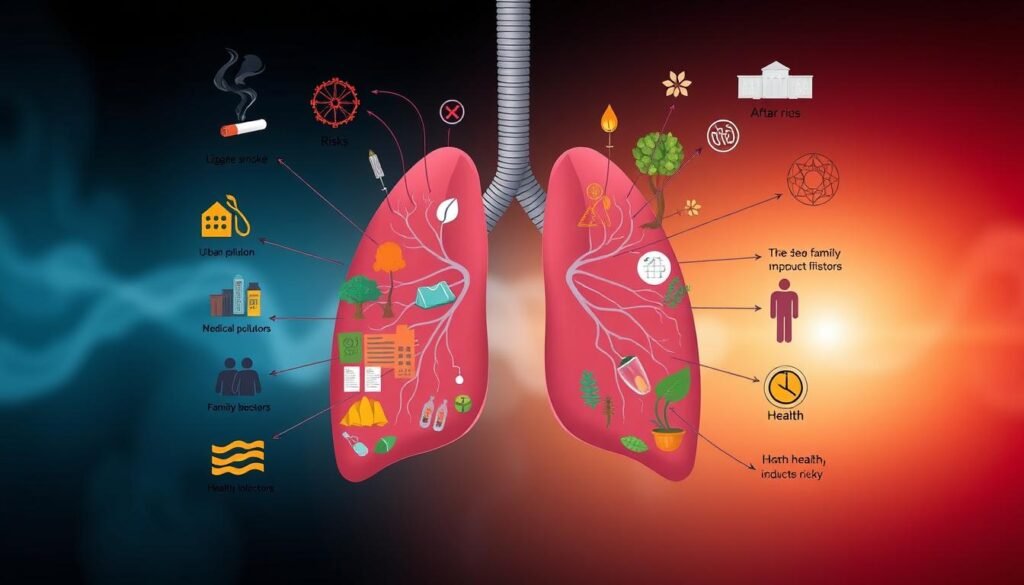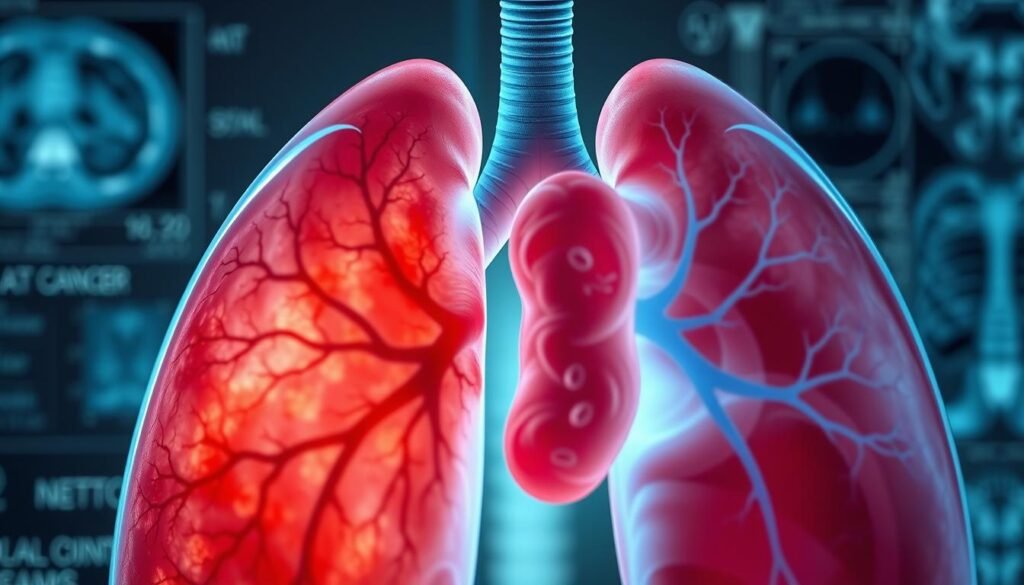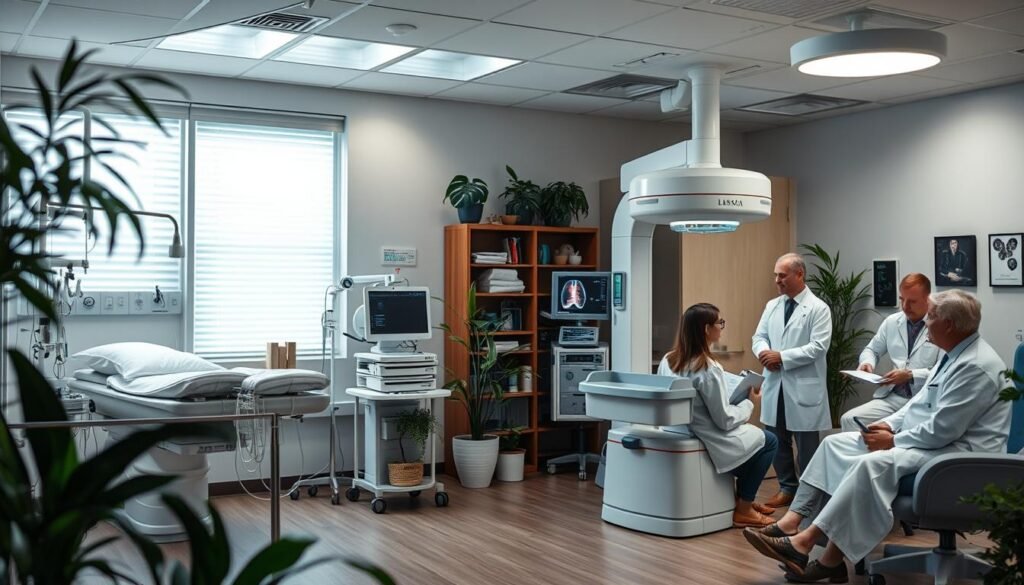Lung cancer development is a slow process, often spanning several years. Types like squamous cell carcinoma need about eight years to grow to 30 mm, a common diagnosis size. This slow growth makes lung cancer a leading deadly disease in the U.S. Knowing how lung cancer progresses is key for improved diagnosis and treatments.
This piece explores lung cancer deeply, including its types, risk factors, and warning signs. Knowing the time it takes for lung cancer to develop helps with prevention and early action.
Key Takeaways
- Lung cancer often takes several years to manifest, complicating early detection.
- Stage 0 lung cancer is highly treatable, while stage IV shows the disease’s advanced progression.
- Tumor doubling time may vary, significantly impacting survival predictions.
- Non-small cell lung cancer has a range of growth rates depending on smoking history and subtype.
- Understanding the lung cancer risk timeline is crucial for timely intervention and treatment.
Introduction to Lung Cancer
Lung cancer is the top cause of cancer deaths worldwide. It poses a major health risk. Alarmingly, only 16% of lung cancer cases are caught early. This results in worse outcomes for many people.
Lung cancers are mainly of two types: small cell (SCLC) and non-small cell (NSCLC). About 15% of lung cancers are SCLC, often in heavy smokers. On the other hand, NSCLC makes up about 85% of cases. It affects a wider group of people. The risk rises notably with smoking habits, including daily and total years of smoking.
Many risk factors are linked to lung cancer. Exposure to secondhand smoke and having a family history of lung cancer are major ones. This highlights the need for cancer awareness. With 60% of patients diagnosed late, raising awareness on symptoms and prevention is key.
To learn more, visit this link. Catching lung cancer early is vital for a better outlook. Joining cancer awareness efforts can improve survival chances by leading to early diagnosis and care.
Understanding Lung Cancer Types
Lung cancer falls into two main types: non-small cell lung cancer (NSCLC) and small cell lung cancer (SCLC). Each type has specific traits, frequencies, and treatments. Knowing these lung cancer types helps in catching it early and treating it effectively.
Non-Small Cell Lung Cancer (NSCLC)
Non-small cell lung cancer makes up 80 to 85% of lung cancer cases in the US. It includes adenocarcinoma, squamous cell carcinoma, and large cell carcinoma. Adenocarcinoma starts in mucus cells of the airways and is the most common. Squamous cell carcinoma happens in the flat cells lining the airways, usually near the lung’s center. Large cell carcinoma has big cancer cells and can occur anywhere in the lungs.
Non-small cell lung cancer grows more slowly than small cell lung cancer. Treatments include surgery, chemotherapy, and radiation. Early diagnosis can lead to a survival rate over 90%.
Small Cell Lung Cancer (SCLC)
Small cell lung cancer accounts for 10 to 15% of cases and is very aggressive. It usually affects smokers, as almost all patients have a smoking history. SCLC quickly grows and spreads, often being found at a late stage.
SCLC is mainly treated with chemotherapy and radiation. Surgery is less common because the cancer spreads quickly. Knowing the differences between these lung cancer types helps in creating personalized treatments. For more details on lung cancer, visit this resource.
How Long Does It Take to Get Lung Cancer
The speed at which lung cancer progresses depends on many factors affecting lung cancer. The kind of lung cancer is very important in this. Non-small cell lung cancer (NSCLC) makes up 80-85% of cases in the U.S. It usually doubles in size every 230 days. However, some tumors may grow faster, doubling in just 19 days.
Small cell lung cancer (SCLC), on the other hand, grows much quicker. It doubles in about 86 days. A study in 2018 showed how NSCLC types differ in growth. Adenocarcinomas double in 261 days, while squamous cell carcinomas in about 70 days. This shows the growth speed can change greatly, which affects treatment.
Race and genes also affect how fast NSCLC grows. For example, it progresses quicker in white Americans than in African Americans or Asian Americans. Whites may advance to a serious stage within a year. But, African Americans and Asian Americans may take up to one-and-a-half years.
Lung cancer can take years to develop, and many don’t show symptoms early on. This can cause delays in finding and treating it. Once symptoms like coughing or breathing issues start, they’re often ignored. This leads to late diagnosis.
If you’re looking for more details on lung cancer’s growth speed, resources are available. The documentation provides important insights into understanding the timeline of lung cancer.
Lung Cancer Risk Factors
Lung cancer risk factors include lifestyle, environment, and genes. Smoking is a major cause. It leads to 80% of lung cancer deaths. This includes cigarettes and marijuana.

Environmental factors are also key. Radon exposure is the second-biggest cause in the U.S. Workplaces with harmful substances also up the risk, like:
- Asbestos
- Arsenic
- Diesel exhaust
- Silica
- Chromium
Radon and other toxics can get into homes, affecting air quality. Living in polluted areas, especially with diesel smoke, might slightly raise lung cancer risk.
Having a personal or family history of lung cancer also increases risk. This is true for those who had chest radiation or survived lung cancer before. Even a little smoking can make lung cancer more likely.
Knowing these risk factors helps in prevention. By paying attention to habits and the environment, people can lower their risks.
Lung Cancer Symptoms to Watch For
Lung cancer can be hard to catch early because the signs are not always clear. Some people might notice lung cancer symptoms soon, which helps their treatment. It’s important to know the early signs and get help if they don’t go away.
Early Symptoms
At first, lung cancer may not cause obvious symptoms. But when symptoms appear, they can include:
- A persistent cough that does not get better
- Coughing up blood or rust-colored spit
- Having a hard time breathing after little activity
- Weight loss and not feeling hungry without trying
- Tiredness that rest doesn’t fix
- Getting sick with lung infections often
- Starting to wheeze when you didn’t before
Knowing and acting on these early signs can help you see a doctor sooner. This can lead to getting the right treatment early on.
Advanced Symptoms
When lung cancer gets worse, the symptoms become more noticeable. Advanced lung cancer symptoms can include:
- More severe chest pain
- A cough that gets more intense
- Pain in the bones and headaches
- Feeling dizzy and very weak
- Loss of feeling or strange sensations
- Yellow skin, showing liver problems
- Swollen lymph nodes, neck, or collar area
If lung cancer spreads, it can lead to other issues. This includes superior vena cava syndrome, which causes swelling in the face and upper body, often with headaches or a change in consciousness. Small cell lung cancer might cause paraneoplastic syndromes, leading to muscle cramps or feeling very tired.
| Type of Symptom | Examples |
|---|---|
| Early Symptoms | Persistent cough, weight loss, shortness of breath |
| Advanced Symptoms | Chest pain, bone pain, jaundice, swelling of lymph nodes |
| Additional Symptoms | Paraneoplastic syndromes, superior vena cava syndrome |
Lung Cancer Diagnosis and Staging
Knowing how lung cancer stages work is key to choosing the best treatment. Doctors use CT scans and biopsies to check for cancer cells. The stage ranges from 0 to IV, showing how far the cancer has spread.
Staging Process Overview
The TNM system is used to figure out lung cancer stages. It looks at:
- T – Size and place of the tumor
- N – If lymph nodes are involved
- M – Whether cancer has spread
| Lung Cancer Type | Stage Classification |
|---|---|
| Non-Small Cell Lung Cancer (NSCLC) | Stage 0, I (1A, 1B), II (IIA, IIB), III (IIIA, IIIB, IIIC), IV |
| Small Cell Lung Cancer (SCLC) | Limited stage, Extensive stage |
Importance of Early Diagnosis
About 53% of lung cancer cases are metastatic when found. Early detection is vital for successful treatment. High-risk individuals, like smokers, should get screened. The American Lung Association says this could lower lung cancer deaths by 20%.
Early diagnosis increases the survival rate significantly. For localized cases, the survival rate is above 63%. That drops to 3% when it has spread far.

Noticing early signs, like a constant cough and losing weight without trying, is crucial. People should learn the early signs of lung cancer. They should get help right away. You can find more info on lung cancer signs here.
Lung Cancer Progression Timeline
The lung cancer timeline shows the disease’s journey from start to advanced stages. Non-small cell lung cancer (NSCLC) usually grows slower than small cell lung cancer (SCLC). This gives NSCLC patients a better chance when found early. Sadly, many are diagnosed in later stages, limiting their treatment options.
Lung cancer stages are determined by the TNM system. This system considers tumor size (T), lymph node involvement (N), and if the cancer has spread (metastasis, M). Stages from 0 to 4 help doctors understand how serious the cancer is.
Knowing the stage of lung cancer is key because it can spread far, even to the other lung, liver, bones, brain, and more. The progression moves through different stages:
- Occult Stage (hidden cancer): TX, N0, M0
- Stage 0: Tis, N0, M0
- Stage I: IA1 (T1mi, N0, M0), IA2 (T1b, N0, M0), IA3 (T1c, N0, M0), IB (T2a, N0, M0)
- Stage II: IIA (T2b, N0, M0), IIB (T1a/b/c, N1, M0); (T2a/b, N1, M0); (T3, N0, M0)
- Stage III: IIIA (T1a/b/c, N2, M0); (T2a/b, N2, M0); (T3, N1, M0); (T4, N0 or N1, M0)
- Stage IIIB: T1a/b/c (N3, M0); T2a/b (N3, M0); T3 (N2, M0); T4 (N2, M0)
- Stage IV: Advanced spread to distant organs.
As lung cancer develops, both patients and doctors need to understand each stage’s impact. Knowing about tumor growth and lymph node involvement helps in picking the right treatment, aiming for the best result.
Lung Cancer Treatment Options
Treating lung cancer means choosing from several options. These depend on the kind and stage of the disease. Knowing about these treatments helps patients and their families make good choices. These choices aim to better their lives and manage the disease well.
Curative Treatments
Curative treatments aim to remove cancer completely. There are a few main ways to do this:
- Surgery: It’s often the first choice for patients in good health with non-small-cell lung cancer (NSCLC) that hasn’t spread. Common surgeries include lobectomy, pneumonectomy, and wedge resection.
- Chemotherapy: It’s key for small-cell lung cancer (SCLC). It can be the only treatment or used with others. Chemotherapy might also help before or after surgery to make treatments work better.
- Radiation Therapy: This might be the only treatment or used with chemotherapy. It targets small tumors. It also helps lower the risk of cancer coming back after surgery.
- Targeted Therapy: If patients have certain gene mutations, this therapy attacks the cancer’s specific traits. This offers a treatment tailored to the patient.
Palliative Care
When lung cancer is too advanced, palliative care is key. This care is about easing symptoms and improving life quality for patients. It includes:
- Pain Management: This ensures patients stay as comfortable as possible through different pain-relief methods.
- Symptom Control: It deals with side effects of treatments like chemotherapy and radiotherapy. This might include managing fatigue and nausea.
- Emotional Support: Offering help to deal with the emotional impact of lung cancer is vital.
Mixing the right lung cancer treatments with good palliative care makes a big difference for patients. These plans should be talked over with healthcare teams to suit each patient best.

Lung Cancer Prevention Strategies
Lifestyle changes are key to preventing lung cancer. The top way to lower your risk is by quitting smoking. Quitting allows your body to heal, reducing your chances of getting lung cancer if you stop early enough.
Being around secondhand smoke is also risky. If you live with someone who smokes, your lung cancer risk goes up. Try to stay away from settings where people smoke to protect yourself.
Radon exposure is another big risk. It’s the second leading cause of lung cancer in the U.S. This gas can get into your house without you knowing. It’s important to test for radon and fix high levels to lower your cancer risk.
Eating healthy helps fight lung cancer too. Fruits and veggies can guard against the disease. Staying active is also crucial. Working out for 30 minutes, five times a week, can help keep lung cancer away.
Screenings are vital for those at high risk. They can catch the disease early, leading to better chances of beating it. Eating well and exercising are part of preventing lung cancer.
Conclusion
Lung cancer is a major health issue, claiming a life every two minutes in the U.S. Over 361 people die from it each day. This highlights the need for action. Understanding lung cancer is key to knowing the risks and the importance of early detection. Though the survival rate has risen to 28.4% recently, only 16.0% of those who should get scanned actually do.
It’s vital to fight lung cancer with awareness. Annual low-dose CT scans can lower death rates by up to 20%. Recent studies show that more screenings could save many lives and cut healthcare costs. Yet, not everyone has the same access. People of color are often diagnosed later and have less access to treatments than white people do.
Efforts in public health are turning towards improving cancer awareness and screening access. It’s also important to overcome the social and cultural barriers to treatment. Together, these actions can lighten lung cancer’s impact on all communities and boost survival rates.